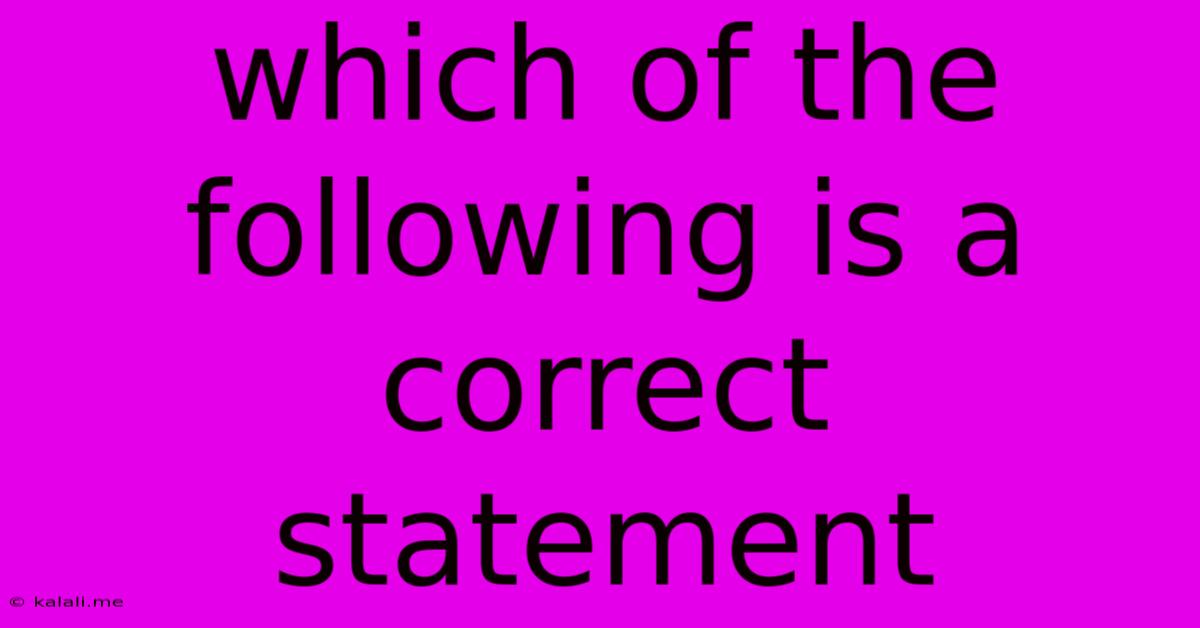Which Of The Following Is A Correct Statement
Kalali
Jun 13, 2025 · 3 min read

Table of Contents
Which of the Following is a Correct Statement? A Guide to Identifying Truth in Multiple Choice Questions
Multiple choice questions (MCQs) are ubiquitous in education, testing, and even everyday life. Understanding how to identify the correct statement among several options requires critical thinking and careful analysis. This article will guide you through effective strategies for tackling these types of questions, improving your accuracy, and boosting your confidence.
What makes a statement "correct"? A correct statement is one that is factually accurate, logically sound, and consistent with established knowledge or principles. It avoids ambiguity, contradictions, and subjective opinions unless explicitly stated as such. The key is to carefully examine each part of the statement, searching for any flaws or inconsistencies.
Strategies for Identifying the Correct Statement:
1. Understand the Question Stem
Before even looking at the options, thoroughly read and comprehend the question stem. What is it asking you to identify? What are the key concepts or keywords? Understanding the question's core will guide your analysis of the answer choices. For example, if the question asks for the most accurate statement, you're looking for the best option, not just a partially true one.
2. Analyze Each Statement Individually
Don't rush! Examine each statement carefully, looking for:
- Factual Accuracy: Does the statement align with known facts and established evidence? Can you verify the information through reliable sources?
- Logical Consistency: Does the statement make logical sense? Are there any internal contradictions or inconsistencies within the statement itself?
- Ambiguity: Does the statement have multiple interpretations or unclear wording? Avoid statements with vague language or subjective claims.
- Scope: Does the statement address the entire question or only a part of it? Sometimes, a statement might be partially true but not fully answer the question.
3. Eliminate Incorrect Statements
Once you've analyzed each statement individually, start eliminating those that are demonstrably false, illogical, or irrelevant. This process of elimination narrows your choices and increases your chances of selecting the correct answer. Focus on identifying specific flaws in each incorrect statement.
4. Compare Remaining Statements
After eliminating incorrect options, compare the remaining statements. Look for subtle differences in wording or meaning. Identify the statement that is most precise, comprehensive, and accurately answers the question.
5. Check for Qualifying Words
Pay close attention to qualifying words like always, never, all, some, most, and usually. These words significantly impact the truth of a statement. A statement using "always" or "never" is much easier to disprove than one using "usually" or "some." Overly broad claims are often incorrect.
6. Consider Context
The context in which the question is presented is crucial. Consider any relevant background information or assumptions provided. This context might offer clues to help you identify the most accurate statement.
Example:
Let's say you're given the following question: Which of the following statements about photosynthesis is correct?
a) Photosynthesis occurs only during the day. b) Photosynthesis produces oxygen as a byproduct. c) Photosynthesis requires carbon dioxide and water. d) Photosynthesis occurs only in plants.
By analyzing each statement, you can determine that:
- a) is incorrect because some forms of photosynthesis can occur in low-light conditions.
- b) is correct because oxygen is a byproduct of photosynthesis.
- c) is correct because carbon dioxide and water are necessary inputs for photosynthesis.
- d) is incorrect because some other organisms, like algae, also perform photosynthesis.
Therefore, while both b and c are correct, if the question asks for a correct statement, either would suffice. However, if the question required the most comprehensive statement, a more detailed analysis is needed to select the best answer.
By mastering these strategies, you'll become more adept at identifying the correct statement in multiple-choice questions, improving your performance on tests and enhancing your critical thinking skills. Remember, practice makes perfect! Consistent practice with various question types will significantly improve your ability to decipher truth from falsehood.
Latest Posts
Latest Posts
-
Able To Be Drawn Into Wire
Jun 14, 2025
-
Which Of The Following Statements Is True Regarding
Jun 14, 2025
-
What Is The Least Common Multiple Of 20 And 40
Jun 14, 2025
-
Temple University Japan Campus Acceptance Rate
Jun 14, 2025
-
Which Of The Following Is Not An Aspect Of Globalization
Jun 14, 2025
Related Post
Thank you for visiting our website which covers about Which Of The Following Is A Correct Statement . We hope the information provided has been useful to you. Feel free to contact us if you have any questions or need further assistance. See you next time and don't miss to bookmark.